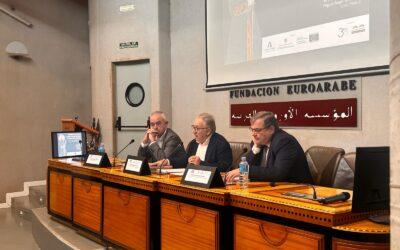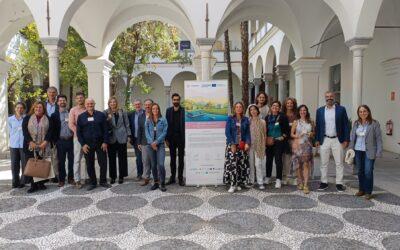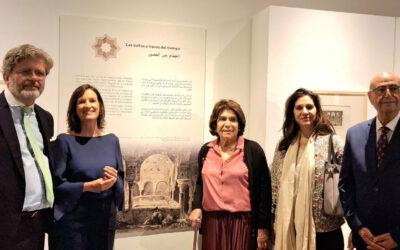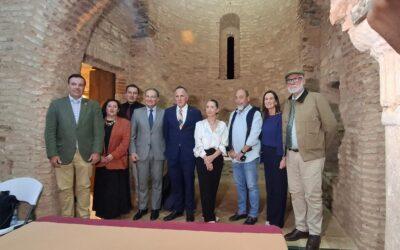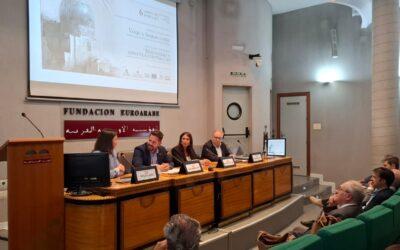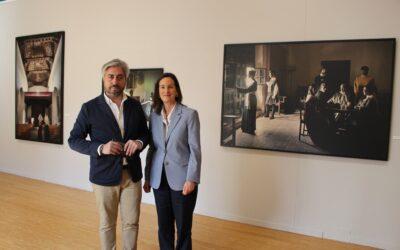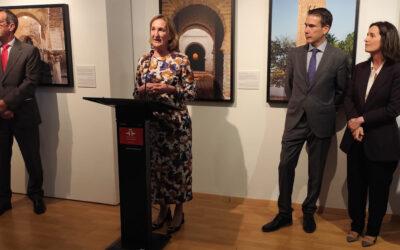 Nearly eight centuries of history of al-Andalus in the Iberian Peninsula have shaped an inheritance that is a part of the hallmarks of Spanish, Mediterranean and European cultures
Nearly eight centuries of history of al-Andalus in the Iberian Peninsula have shaped an inheritance that is a part of the hallmarks of Spanish, Mediterranean and European culturesEXPOSICIÓN VIAJE A SAMARCANDA
Relación de la embajada de Ruy González de Clavijo ante Tamerlán (1403-1406)
— Corral del Carbón, Granada —
Cultural Routes of the Council of Europe
Exhibitions
They bring the splendour of the culture of al-Andalus closer to the public
The Routes
Cultural Route of the Council of Europe since 1997
The Foundation
Its goal is to disseminate and highlight the heritage of al-Andalus in order to recover that mark of progress and tolerance, creativity and ingenuity that contributed so much to the revival of Europe and to the enrichment of its current identity.
TO KNOW MORE
Cultural Itineraries
Cross-border itineraries based on the historical, social and cultural relations of al-Andalus with the Muslim world.
See ITINERARIES
Publishing Work
El legado andalusí has published more than 70 books, of both scientific and educational nature, centred on historical, cultural and tourist subjects.
GO TO PUBLICATIONS CATALOGUE
Lady Mary Wortley Montagu, an Englishwoman in the harem
PART II
The aristocrat’s records of voyage reveal to us how she changed public attitudes towards women’s rights and other issues.
Lady Mary Wortley Montagu, an Englishwoman in the harem
PART I
The aristocrat’s records of voyage reveal to us how she changed public attitudes towards women’s rights and other issues.
René Caillié
El desvelador de Tombuctú
“Al fin llegamos felizmente a Tombuctú, en el momento en que el sol tocaba el horizonte. Veía por fin esta capital del Sudán que desde hacía tanto tiempo era objeto de todos mis deseos. […] Recuperado de mi entusiasmo, comprobé que el espectáculo que tenía ante mis ojos no respondía a mis expectativas”.
Voyage à Tombuctú
René Caillié
El Palermo arabo-normando, reflejo de al-Andalus
La cultura islámica dejó su impronta en un vasto legado que abarcó distintas regiones del Mediterráneo. La convivencia entre las poblaciones nativas dio lugar a una simbiosis que originó el nacimiento de nuevas formas artísticas.
Omar ibn Hafsun y Bobastro
Un personaje histórico para una ciudad
Hay pocos personajes históricos que hayan producido una bibliografía tan contrastada y numerosa como la que ha generado desde el siglo XIX Ibn Ḥafsun, precisamente por las veleidades desplegadas a lo largo de su azarosa vida.
Entre la Alhambra y Tombuctú. Abu Ishaq al-Sahili, arquitecto del desierto y puente de civilizaciones
En el mundo medieval, cuando los mapas aún eran dibujos al borde del mito y las dunas parecían muros naturales entre mundos, hubo un hombre que trazó con su vida una ruta inesperada entre la roja Alhambra y los minaretes de barro de Tombuctú. Ese hombre fue Abu Ishaq al-Sahili, conocido…
Samarcanda, en el corazón de la Ruta de la Seda
En el pórtico del palacio de Aq Saray, una sentencia indica al viajero: ‘Si dudas de nuestro poder mira entonces nuestros edificios’.
La exuberante arquitectura con la que Tarmelán, llamado “el soberano del mundo”, engalanó las ciudades de la yerma estepa asiática alcanza en Samarcanda su máxima expresión estética.
Ibn al-Shaij de Málaga deslumbrado ante el Faro de Alejandría
PARTE II
El Faro de Alejandría, la Séptima Maravilla del Mundo Antiguo, fue ampliamente descrito por autores árabes. De entre ellos, el andalusí Ibn al-Shaij de Málaga realizó una las descripciones más fieles que han existido…
Ibn Arabí de Murcia, al-Sayj al-Akbar
El Más Grande de los Maestros
“Mi corazón es capaz de adoptar todas las formas:
es un prado para las gacelas y un claustro para los monjes cristianos
templo para los ídolos y la Kaaba para los peregrinos
es recipiente para las tablas de la Torá y los versos del Corán
porque mi religión es el amor.
Da igual a donde vaya la caravana del amor,
su camino es la senda de mi fe”.
Ibn Arabí
Ibn al-Shaij de Málaga deslumbrado ante el Faro de Alejandría
PARTE I
El Faro de Alejandría, la Séptima Maravilla del Mundo Antiguo, fue ampliamente descrito por autores árabes. De entre ellos, el andalusí Ibn al-Shaij de Málaga realizó una las descripciones más fieles que han existido…
Caballero sin espada
Las (tres) espadas de Boabdil
La historia de las llamadas comúnmente “Espadas del rey Boabdil” es una de las muchas que, tras su apariencia legendaria, esconde los pormenores de relevantes hechos históricos. Se trata de unas espadas que pasaron a manos de diversas familias nobles castellanas tras la conquista de Granada por las tropas cristianas en 1492.
Al-Ghazal from Byzantium to the Viking country
PART I
By the mid-9th century travelling across the Mediterranean could be very dangerous, especially for an old man like al-Ghazal, who had earned a position in the Cordoban court good enough to be put out on such a hazardous endeavour.
Al-Ghazal from Byzantium to the Viking country
PART II
By the mid-9th century travelling across the Mediterranean could be very dangerous, especially for an old man like al-Ghazal, who had earned a position in the Cordoban court good enough to be put out on such a hazardous endeavour.
León el Africano, caravana fue su patria y su vida la más inesperada travesía
“León el Africano hubiera sido para al-Andalus como un hijo póstumo. Nacido en un momento en el que su civilización madre agonizaba, conoció del exilio no sólo el sufrimiento, sino también sus asombrosos cambios. Fue a veces embajador, a veces aventurero y…
The mystery of the Moor King’s Water Mine of Ronda
Ibn Battuta, the traveler of Islam
The story of the Arma, the Andalusi diaspora in sub-Saharan Africa
The alhóndigas of Granada
Travelling along the Routes of El legado andalusí
European Projects
Recognition and Awards
Agreements and Arrangements
by Angelo Ricci | Nov 14, 2025 | News | 0 Comments
The headquarters of the Euro-Arab Foundation for Higher Studies in Granada hosted last Friday a colloquium that concluded the series dedicated to the figure of Ruy...
by Angelo Ricci | Oct 31, 2025 | News | 0 Comments
The Blue Horizons Workshop: Innovative Water Solutions for Tourism and Climate-Resilient Regions brought together more than 70 participants, both on-site and online, at...
by Angelo Ricci | Oct 31, 2025 | News | 0 Comments
The Routes of El legado andalusí were represented at the 23rd Inland Tourism Fair of Andalusia, Tierra Adentro, held from 24 to 26 October at the Jaén Exhibition...
by Angelo Ricci | Oct 31, 2025 | News | 0 Comments
The exhibition has been organized by the Andalusian Public Foundation El legado andalusí and the Spanish Embassy in Amman, in collaboration with the Jordan National...
by Maica Ruiz | Oct 10, 2025 | News | 0 Comments
Today marks the opening of the exhibition Architecture of al-Andalus. Spaces and Visions, presented by the El legado andalusí Foundation in collaboration with the Town...
by Angelo Ricci | Oct 7, 2025 | News | 0 Comments
Yesterday, the Euro-Arab Foundation hosted the presentation of the book Journey to Samarkand. Account of Ruy González de Clavijo’s Embassy to Tamerlane (1403–1406),...
by Angelo Ricci | Oct 6, 2025 | News | 0 Comments
The city of Lucena is hosting the exhibition El alma deSgranada at the Palace of los Condes de Santa Ana. The event is organized by El Legado Andalusí Foundation in...
by Angelo Ricci | Apr 15, 2025 | News | 0 Comments
The Andalusian Public Foundation El legado andalusí brings to Fez a photography exhibition that highlights the architectural splendour of al-Andalus as a crossroads of...
by Angelo Ricci | Feb 7, 2025 | News | 0 Comments
The Cervantes Institute in Rabat recently hosted the opening of the exhibition Architecture of al-Andalus: A Meeting Point Between Eastern and Western Islam. The...



